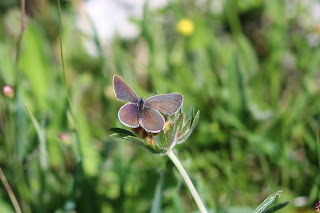Cape Verde 1 : in search of rare petrels and new insects
A year ago an intrepid Scottish birder called Peter Stronach discovered a likely breeding colony of Black-capped Petrels on the island of Santa Antao in the Cape Verde islands. Having had an interest in seabirds since university, this seemed a great opportunity to follow up his observations.
Accordingly 4 of us set off from Bristol airport on Monday Jan 29th 2024 to try and follow in his footsteps.
Santa Antao is not straightforward to reach so we first flew to Lisbon and overnighted in a Holiday Inn Express. The next mornig we caught a TAP flight to Sao Vicente where we planned to explore and seawatch for a few days while working out if we could get ferries to other islands and watch from them.
While this sort of planning seems simple in the world of the internet, it doesn't work like that in the cape verdes.
Our first contact, however was superb meeting us at the airport and handing over our hire car at his office. No paperwork seemed to be involved and we simply set off for a likely seawatching area on the north coast.
From then on it became obvious that very few seabirds were around this early in the year !
Two Brown Boobies were all we saw and those were from a cafe.
I won't give a detailed trip report here but, having set the scene, give a few illustrated highlights of our 12 days.
Most of Sao Vicente was arid with very steep hillsides and a paucity of roads
Given the extreme aridity it seemed an odd place to build a waterpark called Aquafun. As there did not seem to be even a road leading to it the wisdom of the investment escaped me.
Brown Boobies were seen in ones or twos at each spot that we tried seawatching with a couple in the main Bay at Midelo.
The only other seabird we found were Red-billed Tropicbirds but these stayed stubbornly distant. And I do mean distant. Here's the island in the bay:
And here are two tropicbirds flying round it, from the ferry as we passed
See I was not kidding about distance. Here is my best effort from the ferry
Female above and male below.
The one area with water was Midelo water treatment works where a series of shallow pools and settlement tanks attracted virtually every wader on the island. We visited this as often as possible and my colleagues dug out three American vagrants in the form of Lesser Yellowlegs, Ring-necked Duck and Hudsonian Whimbrel. EDIT: I have put in a photo of Wood Sand by error. Thanks to Paul C for noticing that
I did not photograph the Whimbrel.
Dragonflies and Butterflies.
I was far more interested in discovering that my two most wanted dragonflies were both present and spent each visit trying to see them and in particular see them land and photograph them. These two species were Violet Dropwing Trithemis annulata and Wandering Glider (aka Globe Skimmer) Pantala flavescens.
The Wandering Gliders hardly ever landed and I only had one opportunity at a picture which I rather fluffed
Violet Dropwings , 2 males and a female
The best I could manage in flight of Wandering Gliders were these two
Vagrant Emperors always elude me in the UK but here I saw several


























Comments
Post a Comment